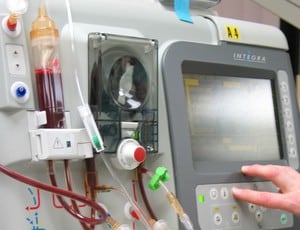CVC insertion site swab and BSI diagnosis

“The novel objective of our study was to determine the capability of insertion skin site culture to predict CRBSI and primary bloodstream infection (PBSI), that include CRBSI and bloodstream infection of unknown origin (BSIUO)” Lorente et al (2021).
Sternal intraosseous devices

“When considering IO vascular access in adults or older children, medical providers should consider the sternum as the recommended IO access” Kearney et al (2021).
IV additive administration best practice standards – Full Text

“We will synthesise the evidence concerning safe and effective preparation and administration of intravenous therapy and medicines to inform the development of a national guideline for healthcare professionals in Ireland” Carr et al (2021).
Infiltration and extravasation reduction in children

“High-quality care was more effective than routine care in reducing the incidence and degree of infiltration and extravasation of peripheral intravenous infusions” Litao et al (2021).
Ultrasound assessment of peripheral IV catheters

Ultrasound assessment of peripheral IV catheters Abstract: Objective: Establish the feasibility of pediatric intensive care unit (PICU) nurse-directed ultrasound assessment (UA) of peripheral intravenous (PIV) catheters, compare the results of UA to traditional assessment (TA), and determine PIV survival after UA. Design: Prospective observational cohort study. Setting: PICU within a children’s hospital. Patients: PICU patients […]
IV access ability whilst wearing PPE

“The study provides evidence that nurses wearing biosafety Level-2 suits were able to obtain intraosseous access faster and more effectively as compared with IV access during simulated COVID-19 paediatric resuscitation” Drozd et al (2021).
PICC-related VTE in cancer patients

“The non-O blood group, larger ratio of PICC diameter:vein diameter, and high level of triglycerides were significantly associated with PICC-related VTE” Li et al (2021).
Automated blood cultures in a resource-limited setting – Full Text

“Implementing automated BC in a resource-limited setting is possible and improves microbiological diagnostic performance” von Laer et al (2021).
Ultrasound vascular access in children

“This article gives a review of the current evidence, the basic knowledge of the technique and the structured approach to follow for supraclavicular ultrasound-guided brachiocephalic vein access in children and neonates” Acosta and Tusman (2021).
Central venous tunneled catheter stabilization

“The single-suture method of the central tunneled catheter exit closure is equal in efficacy to the double suture method” Porazko et al (2021).
Adverse events with biologic infusions – Full Text

“In this study, biologic infusions administered at home, compared with those administered at a facility, were associated with increased adverse events requiring escalation of care” Baker et al (2021).
Preclinical evaluation of passive disinfection caps

“We found that these catheter hubs were compatible, fully operational, and airtight with use of 3M Curos stopper caps after 6 months of use with 122 caps per catheter hub” Simon et al (2021).
Impact of multiple PICC insertions – Full Text

“Although PICCs have been widely used worldwide in various patients, the safety and feasibility of the multiple insertions of the PICC in this population have not been fully verified” Hashimoto et al (2021).
Drug administration and persistent withdrawal occlusion

“We have recently started to assess the intravascular position of the tip and the delivery of the infusion in the proximity of the cavo-atrial junction utilizing transthoracic/subxiphoid ultrasound with the ‘bubble test'” D’Arrigo et al (2021).
Sepsis recognition and management

“Implementation of systems capitalizing on the ability of the electronic health record to constantly screen patients, paired with rapid response teams who can assess and approach sepsis with a standardized algorithm can significantly improve the recognition and management of patients with sepsis, and save lives” Cox and Voss (2021).
Peripheral inotropes in critically ill children

“Results from our study suggest that extravasation injury due to peripheral inotrope infusion is very low (3%) and it may be safely administered in children at a diluted concentration” Mooli and Sadasivam (2021).
Glue for peripheral IV catheter securement

“We conducted a prospective, single-site, parallel, two-arm randomized controlled investigation with a primary outcome of catheter failure comparing securement with standard semi-permeable dressing and clear tape (SPD) to standard semipermeable dressing and clear tape with cyanoacrylate glue (SPD + CG)” Bahl et al (2021).
Knotted PICC in premature newborn

“A clinician should take into account knotting possibility of PICC while formulating the differential diagnosis when faced up to a malfunctioning line” Yilmaz and Çeri (2021).
Why is my renal fistula difficult to access?

“This study aimed to analyze the causes for difficult fistula cannulation, using various imaging modalities” Behera et al (2021).
Back pain associated with parenteral nutrition administration

“The patient’s back pain was ultimately felt to be an adverse reaction to the multivitamin component of the infusion based on an elimination trial of the PN components” Swartz et al (2021).
Non-sterile to sterile drug compounding during a pandemic

Non-sterile to sterile drug compounding during a pandemic Abstract: The drug supply chain has suffered many interruptions over the past decade. The COVID-19 pandemic exacerbated an already fragile infrastructure for supplying critical medications to hospitals and health-systems. The purpose of this paper is to provide insight to the history, thought-processes, and response to critical medication […]
Peripheral IV catheter failure prevention

“Using ultrasonography to all target veins might have contributed to higher success rates of catheterization and extremely low incidence of catheter failure based on objective findings” Abe-Doi et al (2021).
When to use balanced intravenous solutions – Full Text

“Utilization of a large volume of isotonic saline may lead to hypervolemia, hypernatremia, hyperchloremia, metabolic acidosis, and hypokalemia. The use of balanced intravenous solutions has been advocated to avoid these complications” Tinawi (2021).
Nonorthopaedic-related VTE risk with PICC was 61%

“The primary risk factors for NORTH VTEs included intravenous peripheral inserted central catheter/central line (61%; P<0.001) and cancer (27%; P=0.001)" Samineni et al (2021).
Effect of virtual reality on pain during vascular access in children

“Effect of virtual reality on pain during vascular access in children fear, there is significant heterogeneity between studies” Saliba et al (2021).
IV fluid resuscitation in hypotensive cats

“Bolus fluid resuscitation effectively increases blood pressure in hypotensive cats; however, it does not result in normalization of blood pressure, HR, or BT in the majority of cases” Chalifoux et al (2021).
PICC placement in renal patients

“PICC insertion in patients with CKD is practiced frequently. Rigorous strategies should be implemented to improve adherence to clinical practice guidelines and reduce unnecessary insertions and preserve veins for when an AVF may be required” Othman et al (2021).
Occlusion most common implantable port complication – Full Text

“There were 127(10.6%) complications; the most common being catheter occlusion 46(36.2%)” Moralar et al (2021).
Midline catheter and PICC phlebitis rates

“This study provides the first systematic assessment of the risk of phlebitis between midline catheters and peripherally inserted central catheters” Lu et al (2021).
Prevention of vascular access blood stream infections – Free Webinar

“The IPS IV Forum invites you to join our last IV Forum webinar in our Spring webinar series ‘Preventing VAD related blood stream infections’ with speakers Dr Mark Garvey and Professor Jennie Wilson” IPS IV forum (2021).

